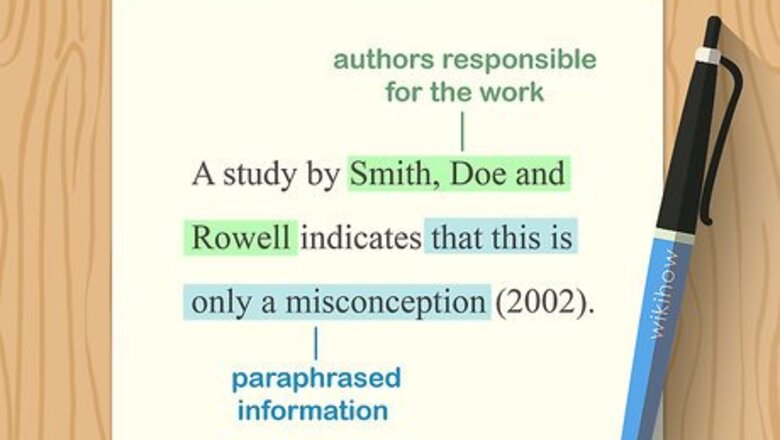
views
X
Research source
Placing Citations in Text
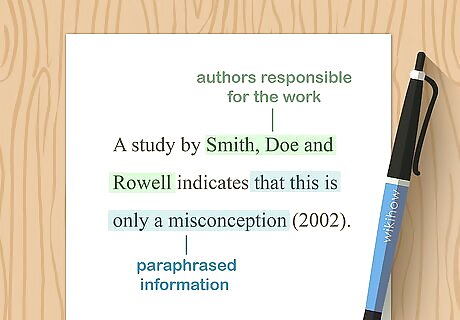
Provide a citation for all information pulled from another source. Generally, if you include any facts, information, or data that you found elsewhere, provide a citation. The citation lets your readers know that the information is not original to you, and allows them to find the original source themselves if they want to read further on your topic. You don't have to cite commonly known and accepted facts. However, you always need to cite ideas. If you're not sure whether a fact is commonly known or not, err on the side of caution and provide a citation. In most cases, the in-text citation falls at the end of the sentence that contains the information from the source. Some citation styles, however, require the citation immediately after the paraphrased information, even if that happens to be in the middle of a sentence.
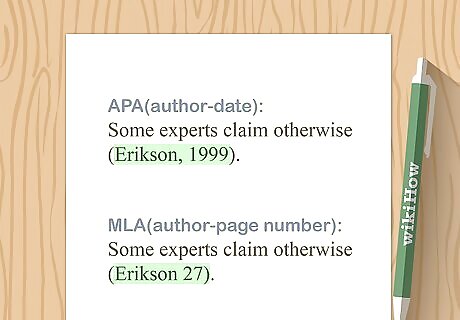
Follow the formatting guidelines for your citation style. Each citation style has a manual that describes the format you should use for in-text citations. You can also get formatting help from your instructor, or from research librarians. Modern Language Association (MLA) style uses an author-page number format for parenthetical citations in the body of your paper. If the source isn't paginated, simply leave that part out and include only the author's last name. American Psychological Association (APA) style uses an author-date format for parenthetical citations in the body of your paper. The Chicago style accepts 2 different methods of in-text citation. You may either use the author-date format, similar to APA style, or you may have footnotes and a bibliography. Chicago-style footnotes include the same information as the full citation in the bibliography, but with slightly different formatting.
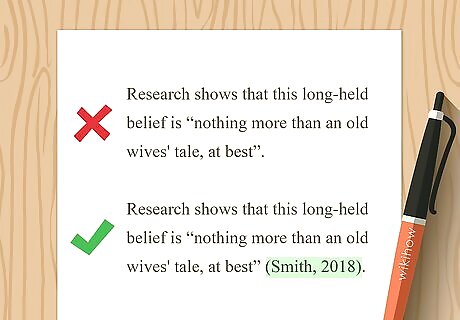
Cite after every sentence with a quote or paraphrase. Regardless of which citation style you use, each quote or paraphrase must be cited individually. Even if you have 3 sentences in a row that all paraphrase the same source, you still have to use 3 citations, rather than just one. The only exception to this rule is a longer block quote set off from the rest of your text. A block quote only requires one citation, at the very end. Generally, you want to avoid having several sentences in a row that paraphrase from the same source. Type a sentence paraphrasing from the source, then add your own thoughts or analysis of that information in the next sentence.
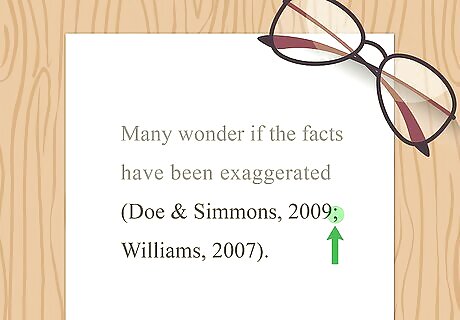
Separate multiple sources with semi-colons. Some sentences in your paper may include information or ideas paraphrased from more than one source. Include all of the sources for the information or ideas in that sentence. Most citation styles require semi-colons to signal to your readers that the sources are distinct from one another. You can also use this format to indicate several sources with more information about a topic that is related to your topic, but beyond the scope of your research. You generally don't have to include full citations to such sources in your reference list.

Include a page number for direct quotes. Some citation styles, such as MLA, require a page number with every citation, whether you quote or paraphrase the work. However, all citation styles require page numbers if you quoted the source directly. If the source is not paginated, some styles require you to use an abbreviation, such as "n.p." Check your style guide to be sure. MLA and Chicago, among other styles, do not require the abbreviation "p." or "pp." before page numbers. However, APA and others do. If you're citing a video or audio recording that has a runtime, include the timestamp range for the specific material you're quoting.
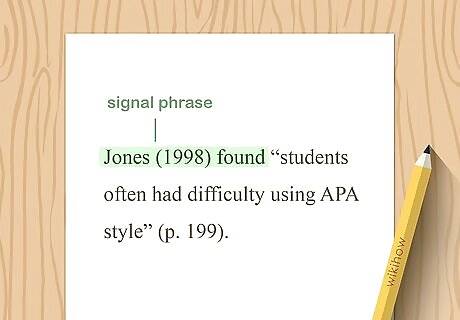
Use signal phrases in your text wherever possible. Repeated in-text citations can bog down your writing and make it more clunky to read. Signal phrases bring information out of the citation and into your text, helping it flow better. Example sentence with signal phrase, APA style: Jones (1998) found "students often had difficulty using APA style" (p. 199). Same sentence without signal phrase, APA style: Research has shown that "students often had difficulty using APA style" (Jones, 1998, p. 199).
Creating a Reference List

Build your reference list before you draft your paper. Regardless of the citation style, an in-text parenthetical citation begins with the first word of the full citation in your reference list (usually the author's last name). If you haven't created your reference list yet, you may not know what to use. Your reference list (also called a bibliography or "Works Cited") includes a full citation for every research source you used for your research project. If you compile the list before you start writing, the writing process will be less disjointed, and you'll run less of a risk of leaving something off. Once you finish writing your paper, go through it and place a mark next to each reference on your reference list that appears in an in-text citation. If any of the sources on your reference list are unmarked, remove them from your reference list.
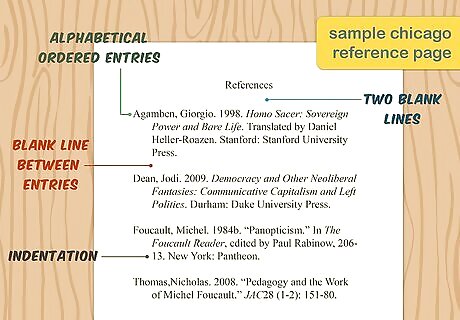
Format your reference list according to style guidelines. Each citation style has slightly different formatting rules for reference lists. These rules cover margins, justification, line spacing, font sizes, and indentations. Look over the rules before you start building your reference list, especially if you're using a different style for the first time. If the rules seem confusing, ask your instructor or a reference librarian for a sample reference list written using that style.
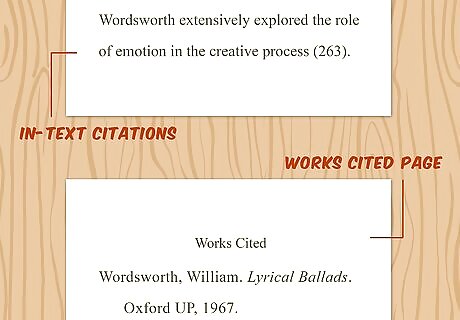
Include an entry for every source cited in your paper. Your citation style also requires a specific format for different types of sources. While all entries include the same basic information, the format allows anyone familiar with the style to know the type of source cited at a glance. For most common citation styles, sources are listed in alphabetical order by the first word in the full citation (usually the author's last name). If you happen to use more than one work by the same author, list them in chronological order starting with the earliest publication date. In rare instances, you may need to include a source in your references that you never cited in the text of your paper. For example, if you're writing a paper about dictatorial regimes and describe them as "Orwellian," you may want to include George Orwell's novel 1984 in your reference list, even though you never cited the novel directly.
Quoting or Paraphrasing a Source
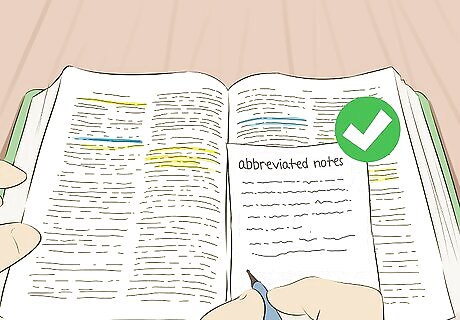
Take abbreviated notes as you read a source. Paraphrasing a source can be difficult if you're reading the passage directly as you write your paraphrase. A better option is to take notes as you read, then write a paraphrase looking only at your notes. Try to avoid looking at the source at all while you're writing. You might inadvertently plagiarize the original content – especially if the author is a particularly efficient writer. Look at the original passage after you've finished your paraphrase to ensure your wording is sufficiently different.
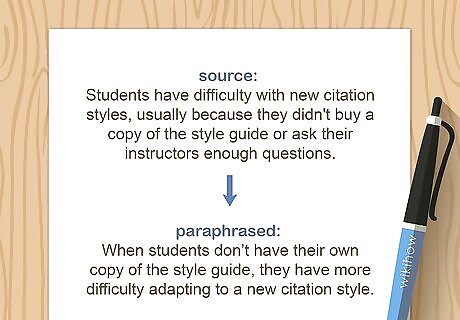
Change the structure of the original passage. A proper paraphrase is written with a different sentence structure and phrasing than the original. You can accomplish this, in part, by starting at a different place in the passage and changing the word order around. For example, suppose your source says "Students have difficulty with new citation styles, usually because they didn't buy a copy of the style guide or ask their instructors enough questions." You can move the start to the middle and paraphrase to say "When students don't have their own copy of the style guide, they have more difficulty adapting to a new citation style."
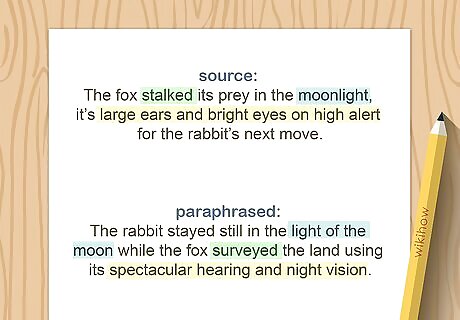
Use synonyms to further distance your paraphrase from the original. Once you've changed the structure, you may still have significant chunks of your writing that directly quote the source rather than paraphrasing it. Changing words to other words or phrases that mean the same thing help eliminate the risk of plagiarism. For example, suppose your source equates EU import rules with "trade protectionism" rather than "reasonable consumer protection." An effective paraphrase could state "EU import rules seem to benefit EU companies more than consumers." After you've changed the structure of the original passage, go back to the source and underline all phrases in your paraphrase that are identical to the original. Try to change as many of these as possible. You can use a thesaurus to find alternate words, but stay away from direct synonyms. For example, if the original source uses the word "feline," changing that word to "cat" won't necessarily help improve your paraphrase.
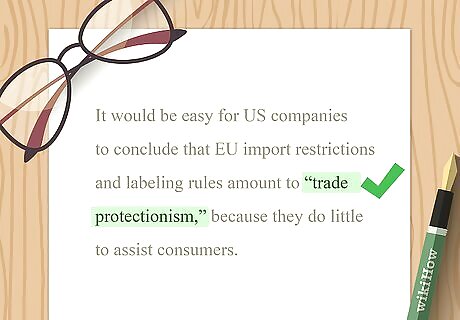
Place quotation marks around unique phrases. Even within a paraphrase, there may be particular turns of phrase that are unique to the original author, but that can't be said any other way. Rather than using alternative phrasing that makes less sense, include partial quotes in your paraphrase to indicate those words appear in the original passage. Example: It would be easy for US companies to conclude that EU import restrictions and labeling rules amount to "trade protectionism," because they do little to assist consumers.

Quote the source directly if the passage is unique or compelling. Sometimes an author may have a particular way of saying something that sticks out to you. If the word choice is clever or evocative, or if the language is so concise you literally couldn't say it any other way, use a direct quote instead of trying to paraphrase. Different styles vary in how long a direct quote can be before you have to set it off as a block quote. Generally, you can quote in line with your text if the quote is fewer than 40 words, or the equivalent of a line or two of text.
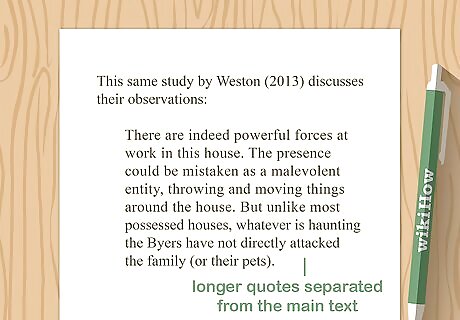
Separate longer quotes from the main text. Rarely you'll find a longer passage that you need to include in your paper verbatim. Citation styles require block quotes to be set off from the main text of your paper, typically starting on a new line with tighter margins. Some citation styles may also require block quotes to have different line spacing than the rest of your paper. When you use a block quote, you only need a citation at the end of the block, regardless of how many sentences you quote. Generally, block quotes should be limited. Only use them if absolutely necessary, and try to limit the length to 3 or 4 sentences at the most.




















Comments
0 comment